Karen and Ryan Hover don’t just make music together, they explore. Their hikes and expeditions into Rocky Mountain National Park, a short hop from their home in Fort Collins, CO, inspire their musical output. Since 2009, the duo recorded as Candy Claws, releasing a series of albums that established their hazy psychedelic sound with a sort of smudged storybook charm. Lyrically, they cover nature, our role in it as humans, the hidden things of our planet yet to be discovered, and what happened during its prehistoric eras.
This time, Karen and Ryan setting their sights on on space, and setting themselves in the future. Or the past. Or…both? Nostalgia for Infinity is the first album from Sound of Ceres, a new band the Hovers founded in 2014, not long after they were married. The couple brought on new members: Robert Schneider, Ben Phelan and John Ferguson, from the Apples in Stereo, Jacob Graham from The Drums, and and Derrick Bozich, to help create a new sound.
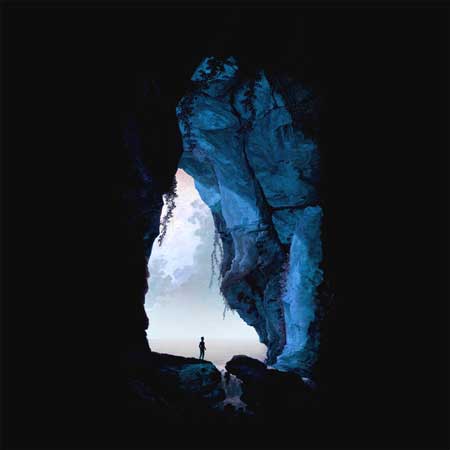
Nostalgia for Infinity’s album art
Of course, having such a distinct sonic palette is tough to shake, and so Nostalgia often has a healthy dose of Candy Claws character, but there are noticeable differences here. Sound of Ceres’ songs are much more synth-driven, more fully realized, and mixed differently. Overall, the album feels more like a solid concept than its predecessors, bringing in new synth textures while still sounding like nothing else in this dimension.
Another somewhat new area for Sound of Ceres is touring. The Hovers didn’t tour much in Candy Claws, as it was a more recording-focused group. Still, Karen said they’re up for the grind, and having their two dogs, Oxford and Zeta, along in the RV makes it that much better.
“It actually makes it a lot more homey. It is a little challenging, just because you know you have to tend to their needs as well and figure out what to do during shows, but the moments that you’re with them, it makes it all worth it,” she said.
I spoke with Karen and Ryan as they were getting ready to embark on Sound of Ceres’ spring tour. We discussed Nostalgia for Infinity, the keys to their dreamy sound, and their much-loved Mellotron sound font.
Sound of Ceres Interview
zZounds: With Sound of Ceres, you two are teaming up with members of the Apples in Stereo and The Drums. How did the new members give this band a different sonic character than Candy Claws?
Ryan: I think this time around they brought a lot of analog synth which we hadn’t had too much of in the past. Ben has a huge collection; he’s kind of a synth nerd right now, he feels a lot of purchase guilt but he makes a lot of good music out of it. Also Jacob from The Drums has this huge modular setup. He contributed a lot of spacey synth lines. Robert from the Apples did a lot of bass lines and also some synths, he didn’t get to play bass much in the Apples, but it’s one of his favorite things to play so this was his chance to get to lay down some bass tracks. And Don actually did a lot of vocals, a lot of layered, Beach Boys-kind of background vocals. He has an amazing talent for those really thick parts.
zZ: I read that when you guys were in Candy Claws you weren’t really fond of touring. Would you say that’s true?
Karen: Yeah I think definitely a while ago back in Candy Claws it was definitely a recording project. We got on the road a few times but it was never something that we particularly felt great about. But with this new project we’ve made a really strong effort to get a really good lineup, a good setlist and talented musicians playing with us.
zZ: Was it challenging to get your songs to sound so big and spacious live?
Ryan: Not too challenging. We use backing tracks live because not everyone can come on the road with us. So we do that for the synth stuff and I’m playing drums, Karen’s playing some synth and percussion, and we have a guitar player named Derrick who is just super amazing. He does like, arpeggio stuff and all the solos and makes it very good live. I think the just the size of the sound depends on if you have a sound guy who’s glued into what we’re going for; not trying to put the vocals right on top, who understands that our vocals blend in a little more so you can push the rest of the sound up a little louder than it would normally go.
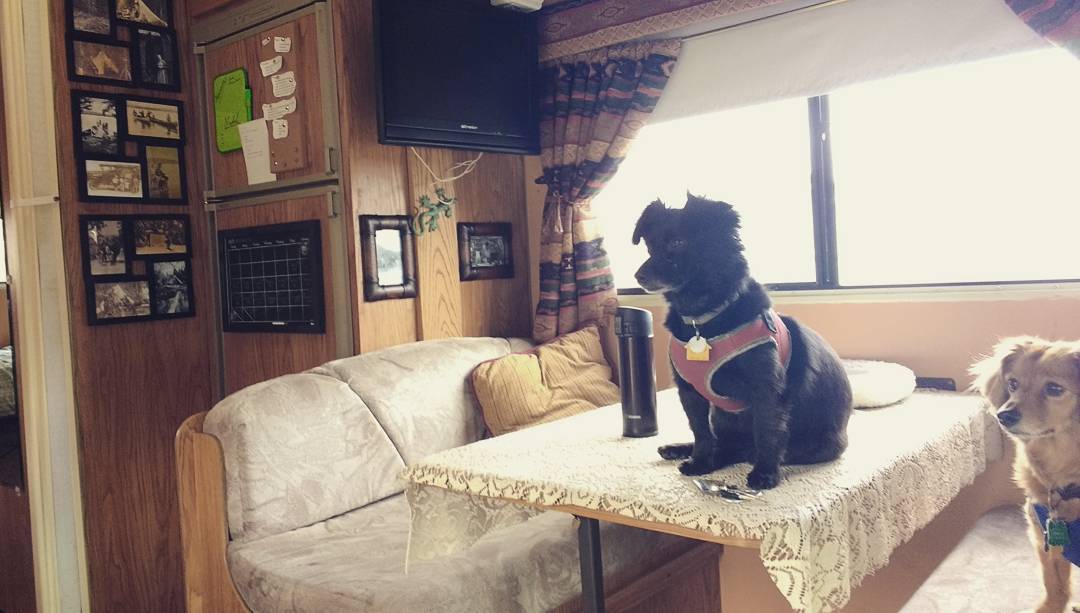
Sound of Ceres’ pets and tour mates, Oxford and Zeta
zZ: So that’s the key to a good Sound of Ceres mix? Maybe the sound engineers should read that when you come to their venue! Speaking of shows, a few years ago, you played at Red Rocks as Candy Claws. Tell me a bit about that show because it seems like the perfect venue for you.
Karen: Yeah, it was a really fun show. We opened for the movie Top Gun which was kind of weird. I think originally we were supposed to open for The Goonies, but somehow it got switched around and we ended up being before Top Gun. It was part of a series called Film on the Rocks which during the summertime they show movies late at night and before the movie they have bands play. Yeah, it was really fun though. There were a lot of people — I think 10,000 people — which is really crazy. Definitely the biggest crowd we’ve ever played to and probably will ever play to. But it was kind of a really fun, surreal-type show.
zZ: Any Kenny Loggins covers for that show?
Ryan: The entire set.
zZ: Gotta give the people what they want.
Karen: Yeah, you could definitely tell that some people were not interested. So it was kind of awkward at times, but it was good.
zZ: I wanted to ask you two about the name “Sound of Ceres.” Is there any connection between it and [Candy Claws album] Ceres and Calypso?
Ryan: It’s a total coincidence.
zZ: Oh yeah?
Ryan: No. Part of it is the new direction is a little more oriented toward space and science fiction and “Ceres” is a nice word because it’s the largest asteroid in the asteroid belt. Some people call it a dwarf planet. But also Karen — who is now our lead singer in the [Sound of Ceres] she played the character of Ceres the White Seal on the last Candy Claws album, so now it’s Karen.
Ceres was the Roman goddess of secrets and the underground. I think it was also fertility for the crops, but we went with the secrets angle. We have a lot of cave imagery as well as space on this album, a lot of that mystery that’s still buried in the world around us that we’re still discovering.
zZ: Can you share some insight on how you came up with the album title, Nostalgia For Infinity?
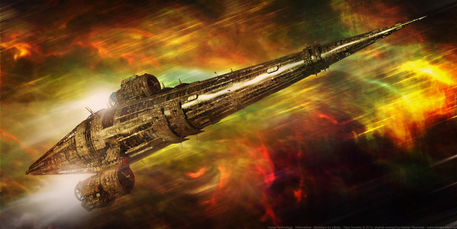
Artwork of the Nostalgia for Infinity Ship from the Revelation Space series (photo credit: artflakes.com)
Ryan: Those three words: “Nostalgia for Infinity” are the name of the spaceship in a science fiction series called Revelation Space that I’m really into. It’s by an author called Alastair Reynolds who was an astrophysicist and writes hard sci-fi, which is sci-fi that’s plausible — it doesn’t have any fantasy elements. This is the main starship in his series that can go close to the speed of light and it’s multiple kilometers long. I haven’t been able to get in touch with him to figure out how he came up with that combination of words, but ever since I started reading these books, I think back in 2010, that phrase has been one of my favorite combinations of words ever made because it pairs this really quaint human feeling focused on the past which is nostalgia, with the word infinity which is almost the opposite: it’s focused everywhere in all directions and it’s something totally inhuman. I think that applies to the themes that we’re exploring on the album: how do we as humans reconcile what we’ve discovered through science with what we can actually experience as human beings? This author actually borrows a lot of titles and things from old prog rock bands, like there’s a planet called Tangerine Dream in his work, so I thought it would repay him to put some of his stuff back into the music world.
It pairs this really quaint human feeling focused on the past which is ‘nostalgia,’ with the word ‘infinity’ which is almost the opposite: it’s focused everywhere in all directions and it’s something totally inhuman.
zZ: Your past releases with Candy Claws have had some Easter eggs — Ceres & Calypso changes based on the time period and Hidden Lands samples each song on every track — Is there anything like that on Nostalgia for Infinity you can let us know about?
Ryan: I think there are some times where the same melody will pop up, like a vocal melody might become a solo in another song. But this time we were trying to be less controlling and obsessive and more collaborative with other people. So I think the main driving framework for this album was each song needs to sound different, like almost its own genre, but still sound like a complete album. Some of my favorite albums are like that, like The White Album, The Broken Social Scene album You Forgot it in People, where each song sounds like it’s been recorded in a different studio almost with different singers, but overall when you listen to it, it’s really a neat journey that it takes you on; it’s still cohesive.
In the past with Candy Claws, we made an effort to make things more cohesive by having the same kinds of sounds, like I would lay down all the drum sounds concurrently so they had the same sounds. But this time we were very piecemeal as far as the songs went, yet still somehow it was something cohesive at the end.
zZ: Can you tell me a little about the gear you were using for this album?
Ryan: Yeah, we just recorded it at home. I have an old Asus Eee PC — it’s a little notebook — and my desktop. Something about it died before we started this album so I put a really light distribution of Linux on my netbook — it’s called Lubuntu, which is kind of the go-to for reviving old computers with low specs. And it runs really great. I just ran a DAW called Ardour; it’s a free, open-source DAW program. And it has really versatile connections within it, like you can connect any track to any bus and back again.
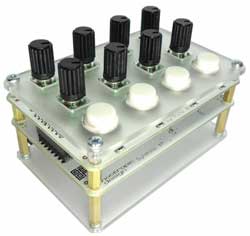
Synthino XM
I’d have to check the model but I think we used a VLA II compressor. We ran everything into that so we had a little bit of compression just to record the sounds going in. In the past we’ve run everything through delay and reverb guitar pedals, but I think this one we did pretty dry, just a bit of compression and we did on-board effects later. Hydrogen was our drum machine on the computer and we ran that through a plugin called Transient Mangler which made the drums sound more natural. That’s how we got these really sterile drum sounds to have a little more life to them. I got a Synthino XM which is sold by a couple of guys. It’s just a tiny little box with four buttons and eight knobs and it’s 4-voice. I just plugged in my Oxygen controller. It’s got four different voices reacting to your input, each with their own waveform and LFO. So that’s how we did a lot of the synthesizer stuff, as well as our other members contributing their Moogs and real analog synths.
We did a lot of hand percussion and I have an old Danelectro guitar that is all the guitar that you hear on the album. I’ve been using that since forever, even on Candy Claws. It just has that nice Danelectro sound that you can’t find anywhere else. And for a lot of the bass sounds on the album I just mic’d an old nylon acoustic that I found at a flea market. I mic’d it and I would either tune the low-E string down to hit some lower notes or I would put it through like a Boss pitch pedal and drop it an octave. The only actual bass sounds on the album are the ones that Robert sent, like “Bryn Marina” has real bass with Robert. But most of the album the bass was either synth or an acoustic that was miked just ’cause I don’t have a bass and I haven’t trained enough on an actual bass to not be in torture when I’m playing. We also did a lot of old Casio tones for a lot of the rhythm keyboard stuff and some of the arpeggiated stuff.
That’s always been our sort of modus operandi, is to see what we can do with the least amount of gear. It’s been a lot of years just hunched over in a bedroom fiddling, and I think if you do something long enough you kind of figure out the little tricks to make it sound good.
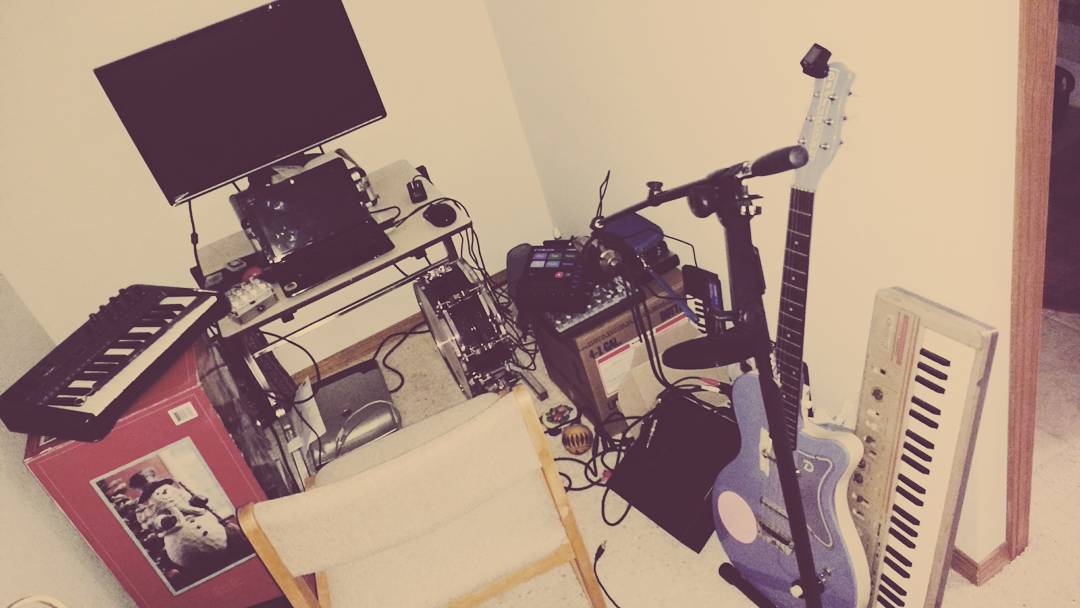
Sound of Ceres’ gear at home
zZ: You and Karen both have a breathy, almost whispery vocal style. Is it difficult to get that to sound the way you want at the levels you need it to be?
Ryan: By now we’ve kind of figured it out. We just have a Behringer condenser mic and we just ran that through the compressor and there wasn’t any noise. In the past we’ve had to put a gate on things and try to get some noise out, but since we started using this VLA II, it sounded a lot richer and there wasn’t any noise. It helps that we had our own little place with no neighbors around and there wasn’t too much stuff happening in the background.
zZ: I know that the Mellotron was a big part of your sound on previous records. Is it present on this album too?
Ryan: Oh yeah, I’m sorry that was like the one thing I forgot to mention. It’s kind of the driving sound behind this record. We found a sound font that someone made, like he took and recorded each key of his actual Mellotron and made a sound font out of it that we just triggered through MIDI. So it’s not like those other Mellotron plugins, because on this one some of the keys are almost too out of tune and they fall off after seven seconds like an actual Mellotron would have, and they’re a lot fuzzier than the synthesized Mellotron ones. For a long time we were experimenting, trying to program a waveform with this fuzzy sound we’ve wanted and then we remembered that we’ve used Mellotron sounds in the past to get that and so we went with that. It appears on every song in the album. It’s kind of our favorite sound; it has that really nostalgic, fuzzy, warbly sound.
zZ: I was also going to ask you about the synth sounds on “Dagger Only Run.” I really like the arpeggio part at the beginning and then towards the verse you have another synth part. I was curious what you were using for that.
Ryan: That was actually an app on my phone. We were traveling or something and just messing around with different apps. The app is called Caustic 3 — it’s a really versatile program and most of the tracks on that album were all programmed in this little phone app which is pretty neat.
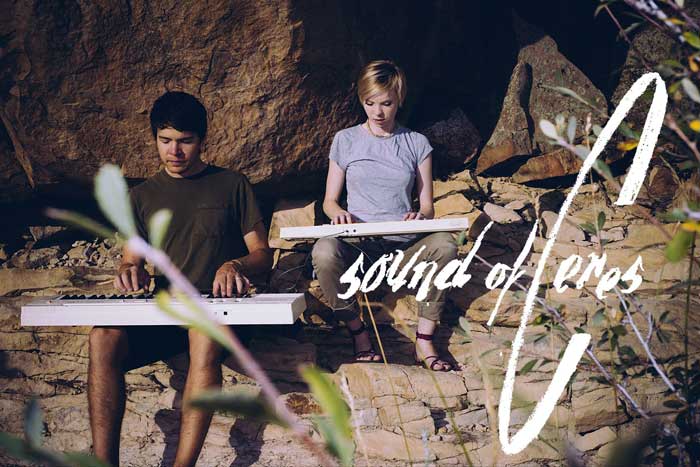
Ryan and Karen play synths in their natural habitat
zZ: Obviously nature is a big theme across your work. With you both being from Fort Collins are you big into hiking and outdoor activities?
Karen: Yeah, we love going up into the Rocky Mountains. We’re just kind of on the edge of it all, Rocky Mountain National Park. So we go there a lot. We do a lot of hiking, snowshoeing in the winter — yeah so I’d say it’s definitely an influence on the music we make as well as what we do in general in life.
zZ: How would you describe the scene in Fort Collins?
Karen: There’s a really big local music scene in Fort Collins and in Denver. There’s a new venue that opened recently in Fort Collins called the Downtown Artery where we’re having our release show and they’re our favorite venue in town. The people are so nice and the sound system and light system that they just made is pretty incredible.
zZ: Is there a network of bands out there that are part of the whole scene?
Karen: There are a lot of bands that have come out of Fort Collins, not that have made it nationally yet, but there are a lot of people that just kind of like being in the Colorado music scene, I’d say. There’s a strong presence of local acts that play a lot of shows around Colorado and do really well with it.

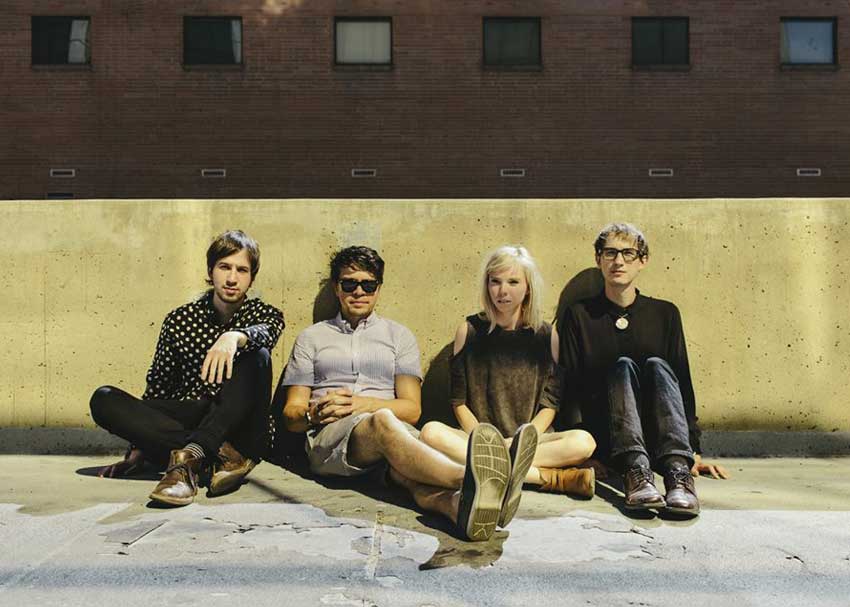


Leave a Reply